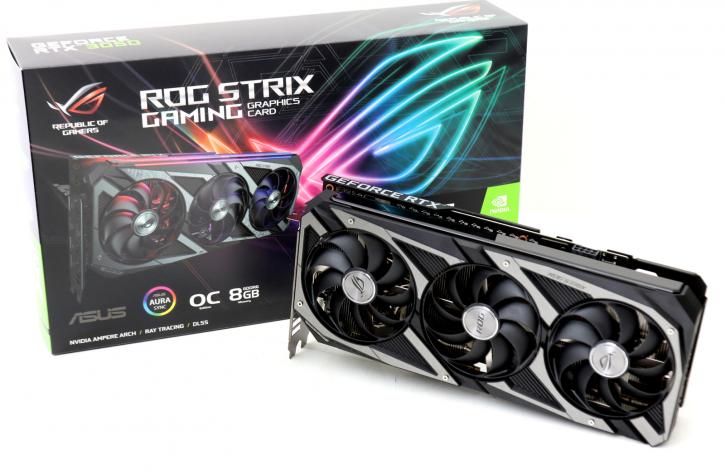Introduction
ASUS ROG GeForce RTX 3050 STRIX Gaming OC 8GB
Impressive performance with an overengineered graphics card
NVIDIA finally complements its 3000 Series lineup with an entry-level to mainstream model performing graphics card series. meet the GeForce RTX 3050. Contrary to AMD's dramatic 200 USD Radeon RX 6500 XT with 4GB/64-bit graphics memory, 1024 shader processors tied to x4 PCIe lanes; the GeForce RTX 3050 is 50 bucks more expensive (MSRP) based on 8GB/128-bit and 2560 shader processors utilizing x8 PCIe lanes. The math immediately becomes visible, NVIDIA will win significantly today. With that 2560 shading cores and Ampere architecture, this 3050 series is bound to impress in the 1920x1080 and maybe even 2560x1440 (WQHD) domain. If stock becomes available in plentiful volumes though, as pricing will be everything. The GPU is again fabricated on an 8nm node derived from Samsung. This process further develops Samsung's 10nm process; no EUV is applied in production just yet. Notable is that a change is in effect, the memory runs at 14 Gbps and finally, entry-level receives 8GB GDDR6. The Ampere lineup nearly doubles ray-tracing performance with Gen2 ray-tracing cores and 3rd iteration Tensor cores. These cards will all be PCIe 4.0 interface compatible and offer HDMI 2.1 and DisplayPort 1.4a, but most importantly is that nicer shader processor count (referred to as CUDA cores by NVIDIA). We now meet the NVIDIA GA106 GPU. And despite being a lower segmented card, it still holds a sizable GPU die. In this round, NVIDIA is not seeding Founder edition cards, aka FE GeForce RTX 3050. But of course, they do present the reference specification; a boost clock of 1777 MHz and a base clock of 1552 MHz.
| GeForce RTX | Base Clock (MHz) | Boost Clock (MHz) | VRAM Base Clock (MHz) | VRAM Effective Datarate (MHz) | Max Power % |
| 3060 Reference | 1320 | 1780 | 1875 | 15000 | - |
| 3050 Reference | 1552 | 1777 | 1750 | 14000 | 0 |
| 3050 ASUS STRIX OC | 1552 | 1860 | 1750 | 14000 | 10 |
| 3050 Palit DUAL OC | 1552 | 1822 | 1750 | 14000 | 7 |
| 3050 Gigabyte Gaming OC | 1522 | 1822 | 1750 | 14000 | 26 |
The ASUS ROG GeForce RTX 3050 STRIX Gaming OC 8GB then; I mean heck yeah, it's pretty wild to see an entry-level product in a STRIX design. The premium entry-level graphics card utilizes the NVIDIA GA106 GPU, this time in a more castrated configuration; it features a shader core count of 2560 and 8GB GDDR6 graphics memory running at 128-bit and 14 Gbps. With beefed-increased cooling, this card features a dual-bios design with performance and silent modes; once the GPU warms up, the three fans begin spinning and cooling. The card is powered by a single (6+2) pin header. Armed with a BIOS that supports a Turbo clock speed of 1860 MHz (1777MHz = reference) under the performance BIOS setting and a cooler that will take your breath away. This card manages to generate 31 Dba noise levels in a Silent BIOS mode at temperatures of 50-55 degrees Celsius. When gaming expects exceedingly silent acoustics. We rate the card as having a normal draw of ~130 Watts. Despite the fact that we tested the factory tweaked model, it overclocks well, and when combined, this results in a product that is slightly quicker than the founder edition requirements for the base model.


